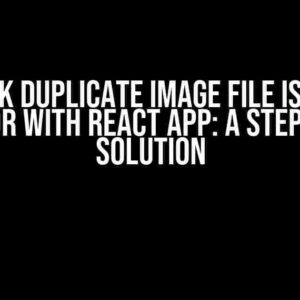Are you building a Django + React app and wondering where to place your React files? You’re not alone! This is a common conundrum many developers face, and in this article, we’ll dive into the pros and cons of placing React files inside the venv directory.
The Venv Directory: A Brief Introduction
For those who may not be familiar, venv is a virtual environment in Python that allows you to isolate your project’s dependencies from the system’s Python environment. It’s a best practice to create a virtual environment for each project to avoid version conflicts and ensure reproducibility.
python -m venv myenv
By running the above command, you create a virtual environment named “myenv” where you can install project-specific dependencies.
The React Files: Where Do They Belong?
Now, let’s talk about React files. In a Django + React app, you’ll have two separate codebases: one for Django (Backend) and one for React (Frontend). The question is, where should you place the React files in relation to the venv directory?
Option 1: Inside the Venv Directory
One approach is to place the React files inside the venv directory. This might seem logical, as it keeps all project-related files in one place. However, this approach has some drawbacks:
- Dependency Conflicts: React and Django have different dependency requirements. By keeping them in the same directory, you risk version conflicts and potential issues with package installations.
- Virtual Environment Purpose: The venv directory is meant for Python-specific dependencies. React files are JavaScript files, which don’t belong in the Python virtual environment.
Option 2: Outside the Venv Directory
The alternative is to place the React files outside the venv directory. This approach offers more flexibility and separation of concerns:
- Clear Separation: By keeping React files separate, you can manage them independently of the Django backend, reducing the risk of conflicts and making it easier to maintain and update each codebase.
- Easier Deployment: When deploying your app, you can deploy the React frontend separately from the Django backend, using different strategies and tools for each.
Best Practice: Keep React Files Separate
Based on the pros and cons, it’s clear that keeping React files outside the venv directory is the better approach. Here’s a suggested project structure:
myproject/ myenv/ (virtual environment) django-app/ (Django backend) app/ models.py views.py urls.py templates/ base.html ... manage.py react-app/ (React frontend) src/ index.js components/ containers/ ... public/ index.html ... package.json webpack.config.js ...
Configuring Webpack and Django
To make this setup work, you’ll need to configure Webpack and Django to communicate with each other. Here’s a brief overview:
Webpack Configuration
In your Webpack configuration (webpack.config.js), you’ll need to specify the output directory and filename for the bundled React code:
module.exports = {
// ...
output: {
path: path.join(__dirname, 'public'),
filename: 'bundle.js',
publicPath: '/'
}
};
Django Configuration
In your Django project, you’ll need to configure the URL patterns to serve the React frontend:
from django.urls import path
from django.views.generic import TemplateView
urlpatterns = [
# ...
path('', TemplateView.as_view(template_name='base.html')),
]
Conclusion
In conclusion, it’s not recommended to place React files inside the venv directory when building a Django + React app. Instead, keep them separate to avoid dependency conflicts, ensure clear separation of concerns, and make deployment easier. By following the suggested project structure and configuring Webpack and Django correctly, you’ll be well on your way to building a successful Django + React app.
Additional Resources
If you’re new to Django and React, here are some additional resources to help you get started:
- Full Stack Python: Django Tutorial
- Tutorials Point: ReactJS Tutorial
- FreeCodeCamp: How to Build a Django React App
Remember, building a Django + React app requires patience, practice, and persistence. With the right guidance and resources, you’ll be creating powerful and scalable web applications in no time!
Frequently Asked Questions
Q: Can I use the same virtual environment for both Django and React?
A: While technically possible, it’s not recommended to use the same virtual environment for both Django and React. This can lead to dependency conflicts and version issues. Instead, create separate virtual environments for each codebase.
Q: How do I deploy my Django + React app?
A: Deployment strategies vary depending on your specific needs. For Django, you can use tools like Gunicorn and Nginx. For React, you can use Webpack’s built-in deployment options or third-party services like Vercel or Netlify.
Q: Can I use a monorepo for my Django + React app?
A: Yes, you can use a monorepo for your Django + React app. However, this approach requires careful planning and configuration to avoid conflicts and ensure separate management of each codebase.
We hope this article has provided valuable insights into building a Django + React app. If you have any further questions or need assistance, feel free to ask in the comments below!
Frequently Asked Question
When building a Django + React app, where should I place my React files? Should they live inside the venv directory or elsewhere? Let’s dive in and find out!
Should I place my React files inside the venv directory?
No way, José! The venv directory is meant for Python virtual environments, not React files. Keep your React project separate from your Django project, and avoid mixing development dependencies.
But won’t it be easier to manage my frontend and backend code together?
While it might seem convenient, it’s not a good idea to mix your frontend and backend code in the same directory. Keep them separate, and use tools like Webpack or Vite to manage your frontend build process. This will keep your code organized and make it easier to maintain and update.
Where should I place my React files then?
Create a separate directory for your React project, alongside your Django project. For example, you can have a `frontend` directory for your React app and a `backend` directory for your Django project. This keeps things organized and easy to manage.
How do I connect my React app to my Django backend?
Use RESTful APIs or GraphQL to connect your React app to your Django backend. Expose your Django backend API endpoints and consume them in your React app using Axios or the Fetch API. This decouples your frontend and backend, making it easier to maintain and update.
Are there any best practices for structuring my Django + React project?
Yes! Keep your project structure organized, with separate directories for your frontend and backend code. Use a consistent naming convention, and consider using a monorepo or multi-repo approach, depending on your project’s needs. Follow established best practices for both Django and React, and keep your code clean, modular, and easy to maintain.



